Link to Pubmed [PMID] – 16946000
Stem Cells 2006 Sep;24(9):2098-109
In fetal liver, bipotential hepatoblasts differentiate into hepatocytes and bile duct cells (cholangiocytes). The persistence of such progenitor cells in adult mouse liver is still debated. In damaged liver of adult murine animals, when hepatocyte proliferation is compromised, bipotential oval cells emerge, probably from bile ducts, proliferate, and differentiate to regenerate the liver. However, treatment to elicit oval cell proliferation is not necessary to obtain bipotential stem cells from adult mouse liver. Here, we have isolated bipotential clonal cell lines from healthy liver of 8-10-week-old C57BL/6 mice. Primary cultures established from hepatocyte-enriched suspensions were characterized by time-lapse image acquisition, immunocytology, and RNA transcript analysis. Although hepatocytes dedifferentiated with loss of apical polarity and other hepatocyte markers, they rapidly activated expression of bile duct/oval cell markers. Reversibility of these processes was achieved in part by culture under dilute Matrigel or by aging of confluent cultures. Cell lines were obtained at high frequency from mass cultures, from isolated colonies, and by primary cloning of the hepatocyte-enriched suspension. Cells of the clonal cell lines do not grow in soft agar and are nontumorigenic, and they express cytokeratin 19, A6 antigen, and alpha6 integrin, as well as a large panel of hepatocyte functions. Furthermore, they can participate in liver regeneration in albumin-urokinase-type plasminogen activator/severe combined immune-deficient mice, where they differentiate in clusters of hepatocytes and occasionally bile ducts. These results demonstrate the existence, in normal adult mouse liver, of a significant pool of clonogenic cells that are (or can become) bipotential.
